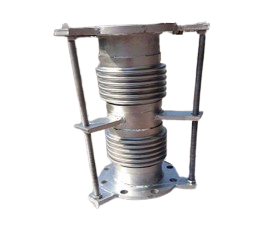Beijing Hownew Energy Technology Group Co., Ltd |
|
Verified Suppliers
|
|
1. Expansion joints(compensators)
Expansion joints, commonly known as compensators, comprise one or more bellows serving as the primary elastic component, along with connectors, supports, flanges, conduits, and other accessories. They are flexible structures installed on vessel shells or pipelines to counter additional stresses from temperature variations and mechanical vibrations.
These joints utilize the expansion and contraction of the bellows to compensate for dimensional changes in pipelines, conduits, and vessels resulting from thermal expansion and contraction. They also accommodate axial, lateral, and angular displacements of pipelines, conduits, and vessels. Additionally, they can be used for noise and vibration reduction and in heating supply systems.
To prevent deformation or damage to heating pipelines caused by thermal expansion or temperature stress, compensators must be installed to mitigate thermal expansion, thus reducing stress on pipeline walls and forces exerted on valves or support structures.
Expansion joints, being elastic compensating components capable of free expansion and contraction, offer advantages such as reliable operation, good performance, and a compact structure. Consequently, they find wide applications in chemical engineering, metallurgy, nuclear energy, and related fields.
There are various types of expansion joints used on vessels, with the U-shaped expansion joint being the most common, followed by Ω-shaped and C-shaped joints. For expansion joints used on pipelines, they are categorized according to structural compensation into universal, pressure balanced, hinged, and gimbal expansion joints.
| Main Item | Classification | Description |
Metal Expansion Joint | ElbowExpansion Joint | Bend the pipe into a U-shaped or other shape, also known as tension bends,are a type of expansion joint that utilizes the elastic deformation ability of the form to compensate. Its advantages are good strength, long service life, and on-site production.The disadvantages are space-consuming, high steel consumption, and high friction resistance. This type of expansion joint is widely used in various steam piping and long pipes. |
Bellows Expansion Joint
| A bellows expansion joint is an expansion joint made of metal bellows. It can expand and contract along the axial direction of the pipeline, and also allows a small amount of bending. In order to prevent exceeding the allowable compensation amount, protective rods or rings are installed at both ends of the bellows, and guide supports are installed on both ends of the connected pipelines. There are also angular and lateral expansion joints, which can be used to compensate for rotational deformations and lateral deformations of pipelines. The advantages of these expansion joints are space-saving, material-saving, easy standardization, and mass production, but the disadvantage is the relatively short lifespan. Bellows expansion joints are generally used in short pipelines with low temperature and pressure. With the improvement of bellows production technology, the application scope of this type of expansion joint is expanding. Currently, bellows expansion joints can be used in pipe systems with a maximum pressure of 6.0 MPa. | |
Slip-Type Expansion Joint | The slip-type expansion joint is composed of inner and outer sleeves capable of relative axial movement, with the space between them sealed by a stuffing box. It is designed to maintain both ends of the pipes moving on the same axis during use. This product mainly includes sleeves (core tubes), shells, and sealing materials, among others. It effectively compensates for axial expansion and rotation of pipelines at arbitrary angles and offers a small volume with a large compensation range, making it suitable for hot water, steam, and grease media. By sliding the inner sleeve against the outer one, it can compensate for thermal expansion. The inner sleeve is connected to the pipeline and features a high-performance self-sealing dynamic seal, enabling it to slide freely within the shell as the pipeline expands and contracts. A seal made of new synthetic material between the shell and inner sleeve ensures resistance to high temperatures, corrosion, and aging, with an applicable temperature range of -40 to 150 degrees Celsius, and up to 350 degrees Celsius under special circumstances. This design not only ensures axial sliding but also prevents leakage of the medium inside the pipe. | |
Non-metallic Expansion Joint | Rubber Expansion Joint | Comprising rubber and rubber-fiber composite materials, along with steel flanges, sleeves, and insulation materials, this product serves as a flexible connection between different fans and ducts. Its primary functions include shock absorption, noise reduction, sealing, resistance to various media, and easy displacement and installation. Widely used in environmental protection applications, it is an ideal accessory for shock absorption, noise reduction, and smoke and dust removal. |
Fabric Expansion Joint | The fabric expansion joint is mainly made of fiber fabric, rubber, and other high temperature resistant materials. It can compensate for the vibration and deformation of fans and ducts.Fabric expansion joints can compensate for axial, lateral, and angular products, with features such as no thrust, simplified support design, corrosion resistance, high temperature resistance, noise reduction, vibration reduction,and others.It is particularly suitable for hot blast pipes and smoke and dust pipeline of power plant.The non-metallic compensator's fiber fabric and insulation cotton itself have the functions of sound absorption and vibration isolation, therefore they can effectively reducing the noise and vibration of boiler, fan, and other systems. Simple structure, light weight, and easy maintenance. |
Super Austenitic Stainless Steel:254SMO,904L,AL6XN
Duplex Stainless Steel :2205 Dual phase steel (S31803)
Nickel Based Alloy Steel:INCOLOY800/800H/800HT/840/825,INCONEL600/601/690/625/X-750
Hastelloy Alloy C-276/C-22/X,MONEL400/K500
Pure Nickel:N4,N6(Ni200,Ni201)
Titanium Plate For Stamping:GR1,GR2,TA1,TA2
Austenitic Stainless Steel:SUS304,SUS304L,SUS316,SUS316L,SUS310S,SUS321,SUS316Ti
2. Metal Expansion joints(compensators)








